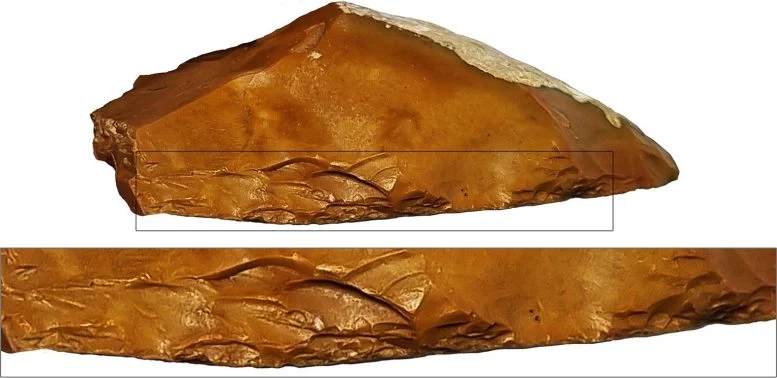The study shows that 400,000 years ago, early humans developed Quina scrapers to hunt, adapt to the disappearance of elephants and establish a cultural connection with the resource-rich mountains of Samaria.
A recent study by Tel Aviv University has revealed the earliest global use of specific stone tools, known as Keen scrapers, dating back 400,000 years. These instruments were first discovered on the territory of France and were named in his honor. These have been found at the ancient sites of Djaljulia and the Kesem Cave. Keen’s scrapers are distinguished by their jagged, sharp working edges, used for slaughtering and skinning deer.
The researchers explain that after elephants disappeared from the region, ancient hunters were forced to make technological adaptations that allowed them to hunt, handle and process fallow deer, a much smaller and faster prey. The study also revealed that the unique tools were made from non-local flint mined in Jaljulia Cave and the mountains of Samaria, about 20 km east of Kesem, which probably also served as a stag calving ground.
Therefore, researchers suggest that the Ebal and Gerizim mountains (near modern Nablus) were considered a source of abundance and sacred to prehistoric hunters as early as the Paleolithic era. The research was led by Vlad Lytov and Professor Ran Barkai from Tel Aviv University’s Department of Archeology and Ancient Cultures of the Middle East. Yakov M. Alkova. The article was published in the journal Archeology.
Evolution of hunting tools
Researchers explain that for about a million years, starting 1.5 million years ago, early humans used stone tools called scrapers to skin and scrape flesh from the bones of mostly large game animals. In the Levant they mostly hunted elephants and other large herbivores, which provided them with most of the calories they needed. But the research showed that after elephants disappeared, about 400,000 years ago, hunters turned to another prey, deer, which were much smaller and faster than elephants.
Litov explains: “In this study, we tried to understand why stone tools changed in prehistoric times, focusing on the technological changes of scrapers in the Lower Palaeolithic period, about 400,000 years ago. We found a striking change in human diet during this period, probably due to the change in the available fauna: large game, elephants in particular disappeared and people had to hunt smaller animals, especially doe. It is obviously one thing to slaughter a large elephant, but it is quite another to process a much smaller and more delicate doe.
Systematic processing of large numbers of elephants to compensate for one was a complex and challenging task that required the development of new tools. “That’s why we’re seeing new Quina scrapers with a better shape, sharper and smoother working edge compared to the simple scrapers used before.”
Conclusion and historical significance
The study is based on findings from excavations at the prehistoric Jajulia site in central Israel near Central Highway 6, where Homo erectus is believed to have lived, as well as evidence from nearby Kesem Cave. At both sites, diggers uncovered numerous scrapers of new types made from non-local flint; their nearest sources are the western slopes of Samaria to the east of the excavated areas or the modern Ben Shemen forest to the south.
Professor Barkai adds: “In this study, we identified a link between technological advancement and changes in the fauna that early humans hunted and consumed. For many years, researchers believed that changes in stone tools were the result of biological and cognitive changes in humans. The dual aspects are both practical and perceptual.” On the one hand, people began to make more complex tools as they had to hunt and slaughter smaller, faster and thinner animals. On the other hand, we also find a perceptual connection: the Ebal and Garizim mountains in Samaria, about 20 km east of Jajulia. It was the habitat of deer and was therefore seen as a source of abundance. We found a connection between a rich source of venison and the flint used to slaughter it, and we believe this connection had perceptual significance for these prehistoric hunters as they knew where the roe deer came from and hunted it. They made special efforts to make tools for cutting, using flint from the same region. “Such behavior is familiar from many parts of the world and is still widely practiced by local hunter-gatherer communities.”
Litov concludes: “We believe that the mountains of Samaria were sacred to the prehistoric people of the Kesem and Jajulia caves because the deer came from there. It is important to note that in Jajulia we also found a large number of other tools made of different types of local stones. Realizing that the elephant population was decreasing, the locals slowly They slowly turned their attention to deer. After identifying a rich source of deer, they began developing unique scrapers in the same place, the first example of a phenomenon that later spread throughout the world.
New scrapers first appeared on a small scale at Jajulia about 500,000 years ago, and a little later on a much larger scale at Kesem Cave, 400,000-200,000 years ago. The Samara Highlands and Kesem Cave east of Jajulia probably hosted a fallow deer population, as evidenced by bone remains from local archaeological excavations during the Pleistocene and Holocene period. Many doe bones have also been found at an altar site on Mount Gerizim, attributed to Joshua ibn Nun in the Old Testament and identified by some traditions as the location of Abraham’s Covenant of Parts described in the Book of Genesis. The mountains of Samaria apparently acquired an important, even sacred status from the Paleolithic period onwards, retaining their unique cultural position for hundreds of thousands of years.













